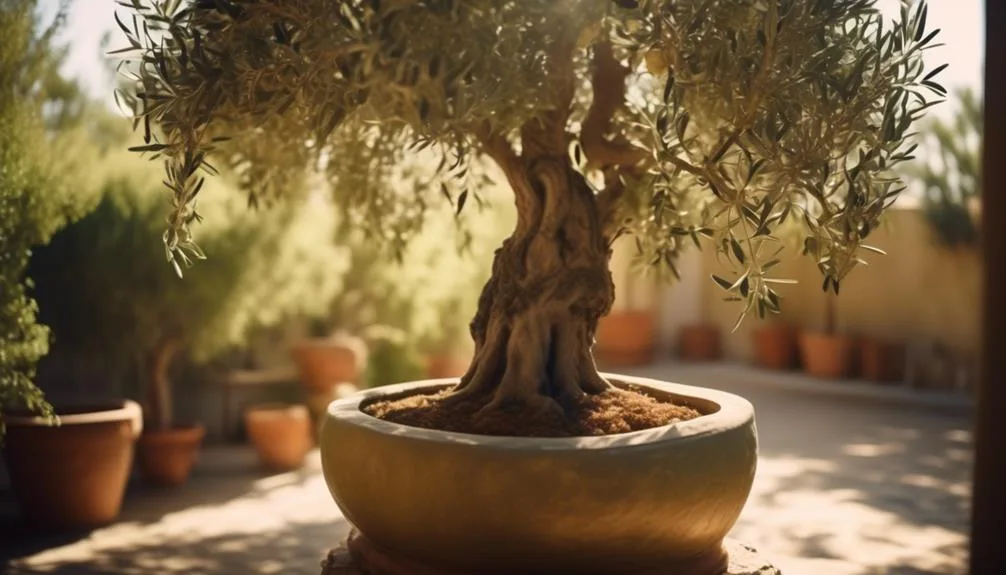Curious about growing olive trees indoors? It's definitely doable with the right info and care. Selecting the right olive tree types, understanding the growing conditions, and dealing with potential challenges are key.
Whether you're a seasoned indoor gardener or just starting out, the idea of having your own olive tree inside is worth exploring. Let's look into how to make it happen.
Key Takeaways
- Choose dwarf olive tree varieties that are suitable for indoor growth and limited space.
- Provide at least six hours of direct sunlight daily by placing the tree near a south-facing window or using grow lights.
- Use a well-draining soil mix and allow the soil to dry out between waterings to prevent waterlogging.
- Regularly prune the tree to maintain its size, shape, and encourage fruiting.
Suitable Olive Tree Varieties for Indoor Growth
When choosing suitable olive tree varieties for indoor growth, it's crucial to consider factors such as size, light requirements, and fruiting capabilities.
For indoor cultivation, consider dwarf olive tree varieties that are better suited for limited space. Select a pot that allows for adequate root development and drainage, usually around 24 inches in diameter.
Regular pruning techniques are essential to maintain the tree's manageable size and encourage fruiting. As for watering, ensure the soil is well-drained and water when the top inch of soil is dry.
Indoors, olive trees require at least six hours of direct sunlight daily, so place them near a south-facing window.
Ideal Growing Conditions for Indoor Olive Trees
To ensure the ideal growing conditions for your indoor olive trees, it's important to consider factors such as light, soil, and temperature, building upon the suitable varieties and care techniques discussed earlier.
When it comes to lighting requirements, olive trees thrive in direct sunlight. If natural light is insufficient, supplement with grow lights. Temperature control is crucial, aiming for a range of 60-85°F during the day and slightly cooler at night.
For pruning techniques, focus on removing dead or damaged branches and maintaining a balanced shape. As for the watering schedule, allow the soil to dry out between waterings, typically every 7-10 days. Use a well-draining soil mix to prevent waterlogging.
Consider the following table for a quick reference:
| Ideal Growing Conditions | Description |
|---|---|
| Lighting Requirements | Direct sunlight or grow lights |
| Temperature Control | 60-85°F during the day, slightly cooler at night |
| Pruning Techniques | Remove dead/damaged branches, maintain a balanced shape |
| Watering Schedule | Water every 7-10 days, allow soil to dry between waterings |
Container Selection and Placement for Indoor Olive Trees
Selecting a suitable container is the first step in growing an indoor olive tree. It should provide ample space for root growth and stability. The container should be at least 2-3 times larger than the root ball to allow for proper growth. Additionally, it is important to ensure that the container has drainage holes to prevent waterlogging, as this promotes healthy root development.
Consider using a terracotta pot for your indoor olive tree. Terracotta pots allow for better airflow around the roots and can help absorb excess moisture. This can prevent issues such as root rot.
When placing the container, choose a spot where your olive tree can receive at least 6 hours of sunlight daily. Olive trees require plenty of sunlight to grow and thrive. If the natural light in your chosen spot is insufficient, you may need to supplement with a grow light to provide the necessary light levels for your tree.
Indoor olive trees also thrive in moderately humid conditions. Consider using a humidifier or regularly misting the leaves to maintain the proper humidity levels. This will help prevent issues such as dryness and leaf drop.
Essential Care and Maintenance for Indoor Olive Trees
Proper pruning is essential for maintaining the health and shape of your indoor olive tree. When it comes to pruning techniques, focus on removing dead or damaged branches, as well as any suckers that may sprout at the base of the tree. It's important to also thin out the canopy to allow better air circulation and light penetration.
Additionally, shaping the tree by selectively trimming branches will help maintain its desired form. As for watering frequency, indoor olive trees prefer to dry out slightly between waterings to prevent root rot. Water thoroughly, allowing excess water to drain, and then wait until the top inch of the soil is dry before watering again.
Potential Challenges and Solutions for Indoor Olive Tree Growth
As you attend to the health and shape of your indoor olive tree through proper pruning and watering, you may encounter various challenges that require your attention and care for the tree's optimal growth. One common challenge is providing adequate lighting for your indoor olive tree. Insufficient natural light can hinder its growth, but you can address this by placing the tree near a south-facing window or using grow lights. Additionally, maintaining the right temperature and humidity levels can be tricky indoors. Fluctuating temperatures and low humidity can stress the tree. To tackle this, consider using a humidifier and regularly monitoring the indoor climate. Here's a table to help you grasp the importance of these factors:
| Challenges | Solutions |
|---|---|
| Lighting limitations | Placement near south-facing window or use of grow lights |
| Temperature control | Regular monitoring and adjustment |
| Humidity levels | Use of humidifier and indoor climate monitoring |
Conclusion
Incorporating olive trees into your indoor gardening can be a rewarding experience. By choosing the right variety, providing optimal growing conditions, selecting suitable containers, and offering essential care, you can successfully nurture olive trees inside your home.
Embracing this opportunity not only adds beauty to your living space but also allows you to enjoy the benefits of cultivating these remarkable trees. So, why not bring the timeless allure of olive trees indoors and savor the joy of tending to them?
Happy gardening!

